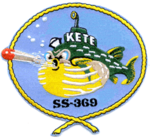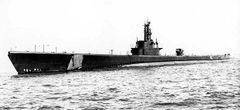USS Kete (1944)
Эта статья редактируется участником yuri83:ru в рамках акции «ЗБТ за статью». Просьба воздержаться от правок.
USS Kete (SS-369)
| 25 октября 1943 Заложен |
| 9 апреля 1944 Спущен на воду |
| 31 июля 1944 Сдан |
| 20 марта 1945 Гибель |
| 1550 / 2463 т. Водоизмещение (надводное/подводное) |
| 95.02 / 8.31 / 5.13 м. Размерения (длина/ширина/осадка) |
| 20.25 узл. Скорость хода надводная |
| 8.75 узл. Скорость хода подводная |
| 120 / 270 м. Глубина погружения (рабочая/предельная) |
| 20000 миль Дальность плавания надводная |
| до 40 суток Автономность (макс) |
| дизель-электрическая . Тип энергетической установки |
| 4 дизельных двигателя General Motors Model 16-278A V16 к-во/л.с. Двигатели надводного хода |
| 4 × электро-двигателя General Electric к-во/л.с. Двигатели подводного хода |
| 1 × 5"(127 мм)/25 . Артиллерийское |
| 10 × 21" (533 мм) 24 торпеды шт Торпедное |
| 1 × 40 мм Бофорс 2 × 20 мм Эрликон шт Авиационное |
| 80-81 чел. Общая численность |
| 10 чел. Офицеры |
| 70-71 чел. Матросы |

Содержание
Постройка лодки
Постройка была начата 25 октября 1943 года Манитовокской судостроительной компанией в Манитовоке. Спущена на воду 9 апреля 1944 года. Спонсором при постройке лодки выступал мистер Е.С. Хатчисон. Принята на вооружение 31 июля 1943 года и поступила под командование Commander R. L. Rutter in command.
Описание конструкции, вооружения
Подводная лодка являлась типичным представителем класса Balao. Отличий по тактико-техническим характеристикам от других аналогичных субмарин не имела.
История службы
Departing Manitowoc 20 August, Kete sailed via New Orleans, Louisiana, to Panama. Arriving 5 September, she trained with SubRon 3 until 28 September; then the new submarine sailed to Pearl Harbor, arriving 15 October, and steamed westward on 31 October for her first war patrol.
She topped off her fuel at Midway Island on 4 November and reached her assigned patrol area in the East China Sea on 15 November in company with Sea Lion (SS-315). Harassed by heavy weather and nonfunctioning bow planes, she sailed 19 November for Saipan, where she arrived 24 November. She departed Saipan with Kraken (SS-370) on 24 December and resumed her war patrol north of Okinawa four days later. Despite prolonged periods of heavy weather, she made lifeguard patrols off the central Ryukyu Islands from 1 January to 27 January 1945 searching for American fliers downed during air strikes on the Ryukyu Islands. After gathering vital weather data, she sailed to Guam and arrived 30 January for refit.
With Lieutenant Commander Edward Ackerman in command, Kete cleared Guam on 1 March for her second war patrol. Assigned to waters surrounding the Nansei Shoto Chain, she resumed lifeguard duty and gathered weather data for the forthcoming invasion of Okinawa. While patrolling west of Tokara Retto on the night of 9 March and 10 March, she surprised an enemy convoy and torpedoed three marus totaling 6881 tons. During the night of 14 March, she attacked a cable-laying ship.
With only three torpedoes remaining, she was ordered to depart the area 20 March, refuel at Midway Island, and proceed to Pearl Harbor for refit. Kete acknowledged these orders 19 March; and, while steaming eastward the following day, she sent in a weather report from a position south of Colnett Strait. She was neither seen nor heard from again. She was scheduled to arrive Midway by 31 March; when repeated attempts to contact her by radio failed she was reported as presumed lost on 16 April.
Circumstances surrounding her loss remain a mystery. The cause could have been an operational malfunction, a mine explosion, or enemy action.
Kete received one battle star for World War II service.
Версии гибели
There are three possible explanations for the Kete's loss; none provide conclusive evidence. The first possibility is that on March 20, 1945, the Kete struck a mine south of Yakushima Island. One-thousand mines were laid in that area on February 27, 1945, by the Japanese minelayer Tokiwa and the auxiliary minelayer Koei Maru. The Kete was moving through that area at a time when the minefield would have been at the peak of its potency. The second possibility is that the Kete was sunk by the Japanese submarine RO-41. The RO-41 was in the area where Kete sent her weather report on March 20th. The RO-41 was also lost during this period and did not report contact with an American submarine prior to her own loss. The third possibility was suggested by the Japanese author and historian Kimata Jiro, who stated that a technical malfunction could have been the reason for the Kete's loss. During her first patrol the Kete's bow planes failed and she had to go to Saipan for repairs. She was there for a month undergoing these repairs. She could have experienced a similar problem on her second patrol and perhaps it was fatal.
Командиры
Награды
Награждена «Звездой за службу» (англ. Battle star).

